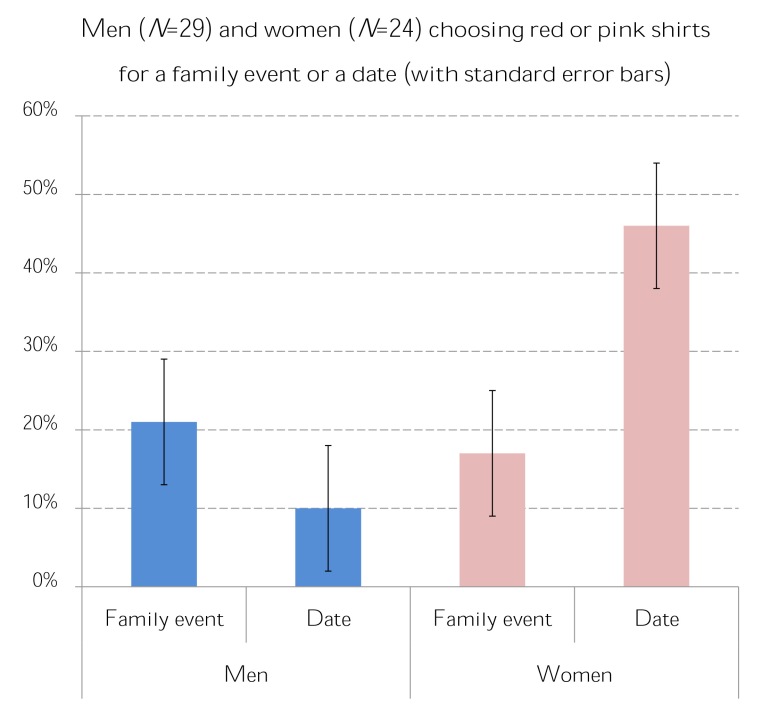In case you haven’t been following the research on this, my understanding is that there is some evidence that women in several cultures are more likely to wear red-related colors when they are trying to look sexually attractive. We know that from the article “Women Use Red in Order to Attract Mates” in the journal Ethos. That’s all well and good, but to make it really interesting, we’d like to know that women are especially likely to do that when they are in the most fertile time in their menstrual cycle. Because, you know:

Unfortunately, that paper from Ethos did not find that red-wearing was associated with menstrual cycles. But, Beall and Tracy were able to find that link. Their conclusion:
Our results thus suggest that red and pink adornment in women is reliably associated with fertility and that female ovulation, long assumed to be hidden, is associated with a salient visual cue.
As Kim Weeden pointed out when I mentioned this on Twitter, Andrew Gelman used that paper as an example of how researchers have many opportunities to slice findings before settling on those that support their hypotheses.
Fortunately, Beall and Tracy set out to replicate their finding. Unfortunately, when they attempted to replicate the results, they were not successful. Fortunately, they realized it was because they were being confounded by the weather. As they have now reported, this is important because in warm weather female humans don’t need to resort to red because they can manage their attractiveness by reducing the amount of clothing they wear (and then, who cares what color it is?). Thus:
If the red-dress effect is driven by a desire to increase one’s sexual appeal, then it should emerge most reliably when peak-fertility women have few alternative options for accomplishing this goal (e.g., wearing minimal clothing). Results from re-analyses of our previously collected data and a new experiment support this account, by demonstrating that the link between fertility and red/pink dress emerges robustly in cold, but not warm, weather.
And here it is. Happy, Gelman?
Confirmatory classroom exercise
Since I am teaching love and romance in my family course this week, I thought we should add something to the conversation. I only did one exercise, and I am reporting the full results here. Nothing hidden, no tricky recodes, no other questions on the survey, no priming of the respondents (it was at the start of the lecture).
I have 80 students in the class, which means 53 were there in time for the exercise, 29 men and 24 women. I gave them this two-part question:
Because red and pink are both associated with fertility (see the baboon), I combined them in the analysis (but it works if you just use red, too). And these were the results:
The statistical test for the difference between date and family event for women is significant at the level of p<.035. This is not research, it’s just a classroom exercise (which means no IRB, no real publication). But if it were research, it would be consistent with the women-wear-reddish-to-attract-mates theory (although without the menstrual cycle question, its contribution would be limited).
Most sociologists might not go for this kind of stuff. Maybe it’s a slippery slope that leads to unattractive conclusions about gender inequality in the “natural” order. My perspective is that I don’t care. Of course this is not really evidence that evolution determines what American (or, in the case of the Ethos paper, Slovak) students wear on dates. But it doesn’t refute the theory, either.
More importantly, I am confident that we could, if desired, through concentrated social engineering, eliminate the practice of women wearing reddish on dates if we thought it was harmful — just as we have (almost) engineered away a lot of harmful behaviors that emerged from the primordial past, such as random murder, cannibalism, and hotmail. After all, they did it in China:
Sorry, wrong picture:
For previous posts in the series, follow the color tag.






The important factors that influence color selection operate at some primordial (primate) level that is out of awareness. So there might be a difference between what students say they would wear and what color they actually choose. In any case, you have to repeat this exercise late in the semester when the weather gets warm. When you do, take a color photo of the class to see who’s wearing what. And don’t forget to include that question about where in their cycle they are.
LikeLike
This would be fascinating to replicate at YU – even while our student body is mostly Modern Orthodox, I have absolutely heard of more yeshivish-leaning students arguing that women should not wear red (or not a lot of it, or not bright red, or any number of permutations). Obviously in chareidi communities, that kind of “social engineering” moves right through “no red” to “stick to black, white, and navy just to be safe.”
LikeLike
You lost me at this quote “Chacma baboons (Papio ursinus), for example,
exhibit an increased level of masturbation when
exposed to an ovariectomised female wearing the artificial
model of a swollen female perineum (presented
in eight different colors) only when the color of the
model was red (Bielert et al. 1989).”I actually think there are better things to do than be cruel to animals. Who cares and why does it matter? I have always worn black and red in Winter never in Summer, make of that whatever you like.
LikeLike
Hey – that’s not my quote! I do not do research on non-human animals. No primates were harmed in the administration of my survey (every student got an attendance point).
LikeLike
Reblogged this on The Life Of Von and commented:
Cruelty to animals – does it matter less than discovering whether women wear red when they’re fertile?
LikeLike
Aware of that but you used the results, guilty by association?
LikeLike
No. If I “used” the results to make a profit (or sell cosmetics), maybe. But reading and discussing a study for educational purposes? Hardly.
LikeLike
Fair enough. Your call. My opinion is my own.
LikeLike
Color me convinced. The White Stripes and Target are clearly onto something. And don’t get me started on Wisconsin, Indiana, Nebraska, and Rutgers …
LikeLike
Right. No accident that Target developed that algorithm to figure out who was pregnant.
LikeLike
Ok, I have some questions about all this: first and foremost, what is the causal link? What’s the theory behind the empirical investigation? How can you disentangle culture from nature, and most important, cultural changes. How can someone have primate instinct when primate didn’t even had clothes and when in nature -i believe- colors are usually a male feature, and not a female one (unless all the documentaries lied! I’m not biologist). The second is more directly related to the study, and, leaving aside the number of observations and the sample design, what about individual effects? Did they follow these women over a period of time? Did they ask them if red or pink where they’re favourite colors? And how are they addressing environmental circumstances, like fashion (it may seem trivial but sometimes you hardly find anything different from the main stream fashion in stores, so if this season is blue and green and yellow good luck finding something pink) or the fact that most women wear is, actually, red or pink. Especially spring and summer clothing. So, yeah, what about reverse causality? I mean…ok, maybe I’m raising trivial question, maybe they have been addressed, but I don’t think they are irrelevant. Especially the theoretical background, is something more and more dismissed these days, while it should actually be the core. Don’t get me wrong, I know how research goes in social sciences, still I find this kind of things slightly worrying.
LikeLike
if red or pink where they’re<- were their, of course, very sorry -__-
LikeLike
The Maryland colors leave me confused; perhaps that is the intent?
LikeLike